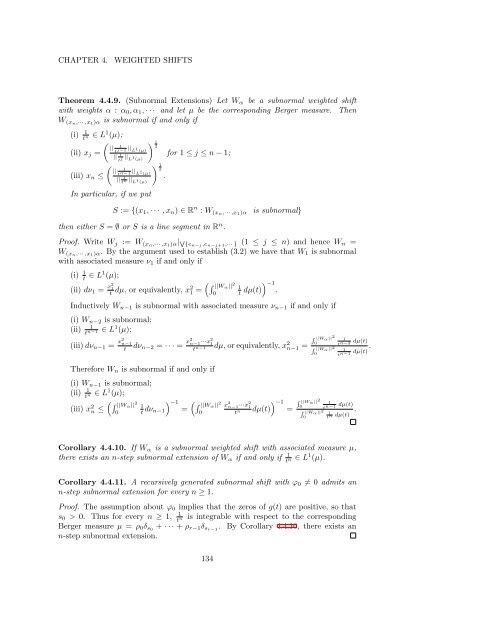Woo Young Lee Lecture Notes on Operator Theory
Woo Young Lee Lecture Notes on Operator Theory
Woo Young Lee Lecture Notes on Operator Theory
Create successful ePaper yourself
Turn your PDF publications into a flip-book with our unique Google optimized e-Paper software.
CHAPTER 4.<br />
WEIGHTED SHIFTS<br />
Theorem 4.4.9. (Subnormal Extensi<strong>on</strong>s) Let W α be a subnormal weighted shift<br />
with weights α : α 0 , α 1 , · · · and let µ be the corresp<strong>on</strong>ding Berger measure. Then<br />
W (xn,··· ,x 1)α is subnormal if and <strong>on</strong>ly if<br />
(i) 1<br />
t<br />
∈ L 1 (µ);<br />
n<br />
(ii) x j =<br />
(iii) x n ≤<br />
(<br />
|| 1<br />
t j−1 || L 1 (µ)<br />
|| 1<br />
t j || L 1 (µ)<br />
(<br />
|| 1<br />
t n−1 || L 1 (µ)<br />
|| 1<br />
t n || L 1 (µ)<br />
In particular, if we put<br />
) 1<br />
2<br />
) 1<br />
2<br />
.<br />
for 1 ≤ j ≤ n − 1;<br />
S := {(x 1 , · · · , x n ) ∈ R n : W (xn,··· ,x 1)α<br />
is subnormal}<br />
then either S = ∅ or S is a line segment in R n .<br />
Proof. Write W j := W (xn ,··· ,x 1 )α| ∨ {e n−j ,e n−j+1 ,··· } (1 ≤ j ≤ n) and hence W n =<br />
W (xn ,··· ,x 1 )α. By the argument used to establish (3.2) we have that W 1 is subnormal<br />
with associated measure ν 1 if and <strong>on</strong>ly if<br />
(i) 1 t ∈ L1 (µ);<br />
(ii) dν 1 = x2 1<br />
t<br />
dµ, or equivalently, x 2 1 =<br />
( ∫ ||Wα || 2<br />
0<br />
) −1.<br />
1<br />
t dµ(t)<br />
Inductively W n−1 is subnormal with associated measure ν n−1 if and <strong>on</strong>ly if<br />
(i) W n−2 is subnormal;<br />
(ii)<br />
1<br />
t n−1 ∈ L 1 (µ);<br />
(iii) dν n−1 = x2 n−1<br />
t<br />
dν n−2 = · · · = x2 n−1···x2 1<br />
t n−1 dµ, or equivalently, x 2 n−1 =<br />
Therefore W n is subnormal if and <strong>on</strong>ly if<br />
(i) W n−1 is subnormal;<br />
(ii) 1<br />
t<br />
∈ L 1 (µ);<br />
n<br />
( ∫<br />
(iii) x 2 ||Wα||<br />
n ≤<br />
2<br />
0<br />
) −1 (<br />
1<br />
∫<br />
t dν ||Wα||<br />
n−1 = 2<br />
0<br />
x 2 n−1···x2 1<br />
t<br />
dµ(t)<br />
n<br />
) −1<br />
=<br />
∫ ||W α|| 2<br />
∫ ||W α|| 2 1<br />
0<br />
tn−2 dµ(t)<br />
∫ ||Wα|| 2<br />
1<br />
0<br />
tn−1 dµ(t).<br />
1<br />
0<br />
tn−1 dµ(t)<br />
∫ .<br />
||W α|| 2 1<br />
0<br />
t n dµ(t)<br />
Corollary 4.4.10. If W α is a subnormal weighted shift with associated measure µ,<br />
there exists an n-step subnormal extensi<strong>on</strong> of W α if and <strong>on</strong>ly if<br />
1<br />
t n ∈ L 1 (µ).<br />
Corollary 4.4.11. A recursively generated subnormal shift with φ 0 ≠ 0 admits an<br />
n-step subnormal extensi<strong>on</strong> for every n ≥ 1.<br />
Proof. The assumpti<strong>on</strong> about φ 0 implies that the zeros of g(t) are positive, so that<br />
1<br />
s 0 > 0. Thus for every n ≥ 1,<br />
t<br />
is integrable with respect to the corresp<strong>on</strong>ding<br />
n<br />
Berger measure µ = ρ 0 δ s0 + · · · + ρ r−1 δ sr−1 . By Corollary 4.4.10, there exists an<br />
n-step subnormal extensi<strong>on</strong>.<br />
134













